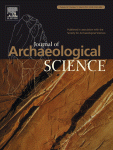| New Volume/Issue is now available on ScienceDirect |
| | Original Research Articles | |
| | 6. | Recent analyses of the excavated textile find from Grave 35 HTR73, Kerameikos cemetery, Athens, Greece Original Research Article
Pages 522-527
Christina Margariti, Stavros Protopapas, Vassiliki Orphanou
Research highlights► Instrumental analysis was applied to the excavated textile find HTR73 from the Kerameikos cemetery in Athens. ► The find is preserved in association with copper. ► Past analyses had indicated the presence of silk fibres. ► ESEM and FTIR microspectroscopy were applied. ► Analyses indicated the presence of cellulosic bast and possibly cotton fibres.
| |
| | 8. | Meta-analysis of zooarchaeological data from SW Asia and SE Europe provides insight into the origins and spread of animal husbandry Original Research Article
Pages 538-545
James Conolly, Sue Colledge, Keith Dobney, Jean-Denis Vigne, Joris Peters, Barbara Stopp, Katie Manning, Stephen Shennan
Research highlights► The problem we are addressing is how, when and where animals were domesticated in Southwest Asia during the Early Holocene. More specifically, we question the widely held view of a single trajectory towards domestication and show that there was great regional variation in faunal exploitation patterns before, during, and after the period in which animal domesticates were first brought under human control; variations which have not previously been properly recognized or defined and which have major implications for our understanding of the domestication process. ► The evidence we provide to support our conclusion is based on a meta-analysis of published zooarchaeological reports describing over 400,000 animal remains from 114 sites in SW Asia and SE Europe from the 12th to the 8th millennium cal BP. This is the most comprehensive account of published zooarchaeological data from the area of interest ever attempted. The data drawn from the exercise is subject to quantitative assessment to document regional variation in exploitation patterns. These analyses are fully documented and include a complete list of the sources used to compile the data. ► We believe the subject matter and our results are of wide enough interest for publication in JAS.
| |
| | 9. | Experimental series and use-wear in bone tools Original Research Article
Pages 546-557
Natacha Buc
Research highlights► On bone tools, use-wear differences are mainly based on striations. ► Skin use-wear is defined by deep and crossed striations. ► Silica-rich plants use-wear is defined by shallow and parallel striations. ► Pottery use-wear is defined by the presence of striations of variable width.
| |
| | 11. | The technological development of stonepaste ceramics from the Islamic Middle East Original Research Article
Pages 570-580
M.S. Tite, S. Wolf, R.B. Mason
Research highlights► Development of stonepaste ceramics produced in Islamic Middle East determined. ► Microstructures of stonepaste bodies studied by scanning electron microscopy. ► Role of firing temperature in determining microstructures investigated.
| |
| | 13. | Experimental micromorphology in Tierra del Fuego (Argentina): building a reference collection for the study of shell middens in cold climates Original Research Article
Pages 588-604
Ximena S. Villagran, Andrea L. Balbo, Marco Madella, Assumpció Vila, Jordi Estevez
Research highlights► High biological action in soils and sediments from the Beagle Channel coasts. ► Sea-mammal bones from the beach are calcitic with wide dissolution areas. ► Sea-mammas from beached individuals are not deeply dissolved and bioeroded. ► Burning traits of Mytilus edulis correspond to stages of bio-aragonite transformation with heat. ► Burning traits allow interpreting hearth temperature and re-arrangement of archaeological combustion structures.
| |
| | 16. | The use of predictive modelling to target Neolithic settlement and occupation activity in mainland Scotland Original Research Article
Pages 633-656
Dorothy Graves
Research highlights►First predictive models targeting Neolithic domestic activity in Scottish mainland. ►Timber halls, pits, and chambered cairns are used as input sites. ►Significant environmental criteria for site presence of input sites identified. ►Key priorities for refining significant environmental criteria identified. ►Models can be utilized to help target fieldwork in understudied or overlooked areas.
| |
| | 19. | Identification of a possible engraved Venus from Předmostí, Czech Republic Original Research Article
Pages 672-683
Francesco d’Errico, Martina Lázničková-Galetová, Duncan Caldwell
Research highlights► An examination of the authenticity of a feminine anthropomorph labelled as coming from Předmostí. ► The engraving on a bone shaft fragment is highly similar to the known Schematic Venus of Předmostí. ► The relationship between the engraving and the bone's alteration was analyzed microscopically. ► No evidence was found to suggest artificially aging. ► So the engraving can be plausibly attributed to the Gravettian, warranting further study.
| |
| | 20. | Non-destructive provenance study of cuneiform tablets using portable X-ray fluorescence (pXRF) Original Research Article
Pages 684-696
Yuval Goren, Hans Mommsen, Jörg Klinger
Research highlights► Revealing the origin of cuneiform tablets sheds new light on the historyof the ancient Near East. ► Scientific provenance studies of clay-derived artifacts in archaeology are often based on intrusive methods. ► Portable X-Ray Fluorescence (pXRF) apparatus was tested to determine its potential for routine provenance studies of tablets. ► The results corroborate the high potential of the pXRF for non-destructive study of well-defined, ‘closed’ assemblages of clay-derived, delicate artifacts.
| |
| | 22. | Application of a new typological approach to classifying denticulate and notched tools: the study of two Mousterian lithic assemblages Original Research Article
Pages 711-722
Andrea Picin, Marco Peresani, Manuel Vaquero
Research highlights► In this paper a new quantitative approach to the classification of denticulates and notched tools is proposed. The new methodology is based on measuring the length of notches and their distribution on the perimeter of the blank. ► The analyses led to the identification of 11 redundant forms: eight denticulates and three notched tools. ► The application of Kuhn's GIUR brought local manufacturing trends to light, calling into question the presumed geographical uniformity of these categories of artifacts.
| |
| | 23. | A new ornamented artefact from Poland: final palaeolithic symbolism from an environmental perspective Original Research Article
Pages 723-733
Tomasz Płonka, Krzysztof Kowalski, Małgorzata Malkiewicz, Jan Kuryszko, Paweł Socha, Krzysztof Stefaniak
Research highlights►New forms of symbolic culture appeared at the end of Late Palaeolithic related to ecological changes in NW Europe. ► Elk became one of the most important animals on the Great Plain. ► There were produced symbolic artefacts made of its antler, and the elk itself is a subject of art. ► Hunters and gatherers of Final Palaeolithic created special arrangements of zigzag motifs and anthropomorphic representation. ► Proliferation of zigzag line motif in the Final Palaeolithic may be connected with importance of water symbolism.
| |
| | 24. | Vein quartz in lithic traditions: an analysis based on experimental archaeology Original Research Article
Pages 734-745
Killian Driscoll
Research highlights► Analysis of experimental quartz knapping ► Complexity involved in analysing quartz assemblages ► Significant differences between the debitage products of quartz and chert ► Bipolar knapping is generally easy to differentiate from direct percussion ► Difficult to differentiate between soft and hard hammer percussion
| |
| | 25. | The environmental context of a prehistoric rock carving on the Bjäre Peninsula, Scania, southern Sweden Original Research Article
Pages 746-752
Alex D. Brown, Richard J. Bradley, Joakim Goldhahn, Jenny Nord, Peter Skoglund, Virgil Yendell
Research highlights► We use pollen analysis to examine the landscape context of prehistoric rock carvings in Sweden. ► This is the first study of its type. ► Pollen data show rock carving was isolated in the landscape in contrast to other monument types. ► Our results show benefits of testing archaeological hypotheses using palaeoenvironmental data.
| |

|




